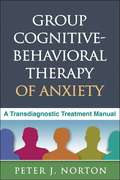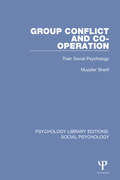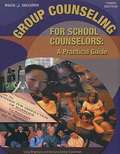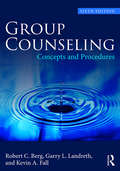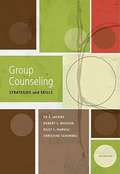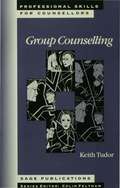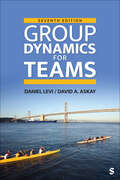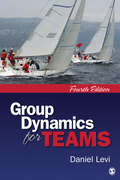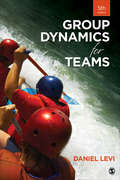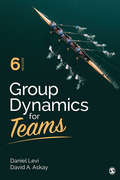- Table View
- List View
Group Cognitive-Behavioral Therapy of Anxiety
by Peter J. NortonCognitive-behavioral therapy is highly effective in the treatment of anxiety disorders, regardless of the specific type of fear that is causing difficulties. This practical, hands-on clinical resource presents a proven group treatment protocol for patients with any anxiety diagnosis. Step-by-step guidelines are provided for setting up transdiagnostic groups, using comprehensive assessment to plan and monitor treatment, and implementing carefully sequenced cognitive and behavioral techniques. Clinical examples illustrate the nuts and bolts of intervention across different anxiety disorder presentations. Special features include 19 reproducible handouts and forms that can be downloaded and printed in a convenient 8 1/2" x 11" size.
Group Communication: An Advanced Introduction
by Torsten Reimer Ernest S. Park Joseph A. BonitoIn this comprehensive, advanced introduction to group communication, the field’s leading experts summarize theory, methodological advancements, and current research in the field. This book follows a coherent structure specifying clear objectives and evidence-based practical implications for the management of groups. Each chapter provides case study examples highlighting the role of communication for group functioning. The textbook takes a particular look at recent advancements in the research on virtual teams, the role of technology in group communication, and issues of diversity and inclusion, considering group communication in various situations including health and organizational contexts. It features theory-driven descriptions, an emphasis on empirical findings, and reflections on research methods. The book is an integrative and coherent textbook for advanced undergraduate and graduate group communication classes and a useful reference for students, scholars, and group communication professionals across different disciplines including communication studies, psychology, life sciences, business administration, management, and engineering. Online resources include a sample course syllabus, discussion questions, lecture slides, and a test-bank. They are available at www.routledge.com/9781032114712
Group Conflict and Co-operation: Their Social Psychology (Psychology Library Editions: Social Psychology)
by Muzafer SherifOriginally published in 1966 the author challenges the accepted theories of group conflict of the time, such as frustration and maladjustment. For him conflict and its accompanying aggressiveness are features of interaction between groups and he supports this theory with a detailed experimental study of controlled groups. At the time of publication, Dr Otto Klineberg, Director of the International Centre for Intergroup Relations at the Sorbonne wrote: ‘Social scientists everywhere owe a great debt of gratitude to Professor Sherif. The distinguished series of publications for which he and his co-workers are responsible have an honoured place in our libraries. In particular, his contributions to the field of intergroup relations are outstanding; his concept of "superordinate goals", based on a combination of theoretical insight and brilliant experimentation, has become a household word for those concerned with this significant problem. In his new volume, Group Conflict and Co-operation, he carries his analysis much further, not only describing the results of several original investigations, but also building a theoretical appraisal of an extensive research literature. The author has made still another significant contribution toward a better understanding of one of the most complex and disturbing phenomena of our time.’
Group Counseling
by Robert C. Berg Garry L. Landreth Kevin A. FallFirst published in 1979, Group Counseling has consistently been a widely used and praised text, providing both novice and experienced counselors with a framework from which to expand their group counseling skills and knowledge. This fifth edition has been thoroughly revised and updated to reflect the newest work in the field, the 2009 CACREP standards, and the Association for Specialists in Group Work practice standards. As in the previous editions, the authors draw upon their extensive experience and share their own styles of leading groups as a personal and practical way to illustrate the differences in group leadership. Berg, Landreth, and Fall present a thorough discussion of the rationale for using group counseling with an emphasis on the group's role as a preventive environment and as a setting for self-discovery. The authors examine the group facilitator's internal frame of reference and ways to overcome of initial anxiety about leading groups, and they also explore typical problems in the development, facilitation, and termination of the group process and provide suggested solutions. Application of group counseling is considered with children, adolescents, adults, as well as with special populations, such as abused children, juvenile offenders, and individuals with emotional difficulties. A helpful glossary of group counseling terminology provides a quick reference source for important terms. New to this edition are a chapter on diversity and social justice in group work an expanded chapter on co-leadership, a topic often ignored in other group counseling texts separate chapters on group work with children and group work with adolescents so that reader can focus more easily on the unique aspects of working with each population a chapter on evaluating groups at the leader, group, and individual member levels. A collection of supplemental resources is available online to benefit both instructors and students. Instructors will find PowerPoint slides and test banks to aid in conducting their courses, and students can access questions for thought and reflection to supplement their review of the chapters in the text. These materials can be accessed at www.routledgementalhealth.com/cw/Berg
Group Counseling and Psychotherapy With Children and Adolescents: Theory, Research, and Practice
by Zipora ShechtmanMany children and adolescents face developmental or situational difficulties in areas where they live most of their meaningful experiences-at home, at school, and in the community. While adults who struggle with life events and stressors may look to professional help, young individuals are quite alone in coping with these situations. Perhaps unsurprisingly, most children and adolescents typically do not seek such help, and often resist it when offered. Author Zipora Shechtman has written this detailed text advocating group counseling and psychotherapy as a viable means of addressing these issues if we are to ensure the psychological wellness of children in society. Group Counseling and Psychotherapy With Children and Adolescents is arranged in four parts. Its chapters explore topics including:*who needs group counseling and psychotherapy;*therapeutic factors in children's groups;*activities in the group;*pre-group planning and forming a group; and*how to enhance emotional experiencing and group support. This text is a principal source of information for counseling psychology students, researchers, and practitioners working with young people, in addition to social workers, teachers, and parents.
Group Counseling for School Counselors
by Greg Brigman Barbara GoodmanGet guidance for preteen and adolescent issues with this step-by-step, field-tested resource! Addresses topics such as social skills, academic support, conflict resolution, and more Applies group plans for each academic level elementary, middle, and high school Presents lessons in an easy-to-follow and developmentally appropriate style.
Group Counseling with LGBTQI Persons Across the Life Span
by Kristopher Goodrich Melissa LukeThis unique resource provides strengths-based, group counseling strategies designed to meet the needs of LGBTQI clients in a variety of settings. Drs. Goodrich and Luke capture the developmental concerns of LGBTQI individuals throughout the life cycle as they establish and maintain intimate relationships, create families, encounter career concerns, and navigate other milestones and transitions. Illustrative case examples and interventions throughout the text, as well as warnings and recommendations, make this an ideal resource for practice and group work courses. After a discussion of the history of group work with the LGBTQI community, the planning and process issues that group leaders should consider in their work, and relevant ethical and legal concerns, the authors explore a range of group types and pertinent issues. Individual chapters focus on the following types of counseling: child and adolescent; same-gender adult; intersex and transgender; coming out/disclosure; school, community outpatient, and residential; couples and family; substance abuse; grief and loss; and advocacy. Chapters on group work supervision and the importance of allies round out the book. *Requests for digital versions from the ACA can be found on wiley.com. *To request print copies, please visit the ACA website here. *Reproduction requests for material from books published by ACA should be directed to permissions@counseling.org.
Group Counseling: Concepts and Procedures
by Robert C. Berg Garry L. Landreth Kevin A. FallFirst published in 1979, Group Counseling has consistently been a widely used and praised text, providing both novice and experienced counselors with a framework from which to expand group counseling skills and knowledge. This revised sixth edition offers a reader-friendly and engaging journey through the group process that is congruent with 2016 CACREP standards and the Association for Specialists in Group Work (ASGW) practice standards and grounded in the most cutting-edge research and theory. The authors present a thorough discussion of the rationale for using group counseling with an emphasis on the group's role as a preventive environment and as a setting for self-discovery. They examine the group facilitator's internal frame of reference and ways to overcome initial anxiety about leading groups, and they also explore typical problems in the development, facilitation, and termination of the group process and provide suggested solutions. Individual chapters are included to explore the application of group counseling with children and adolescents. Notable additions include: an expanded chapter on diversity and social justice in group work; an expanded chapter on co-leadership, a topic often ignored in other group counseling texts; a new chapter on ethics and leadership training; a reworked chapter on leader functions, styles, and skills; and a reworking of the chapter on group counseling with children that includes an in-depth look at Landreth's innovative and empirically validated Child-Parent-Relationship Therapy.
Group Counseling: Concepts and Procedures
by Robert C. Berg Garry L. Landreth Kevin A. FallFirst published in 1979, Group Counseling has consistently been a widely used and praised text, providing both novice and experienced counselors with a framework from which to expand group counseling skills and knowledge.This revised seventh edition offers a reader-friendly and engaging journey through the group process that is congruent with CACREP standards and the 2021 Association for Specialists in Group Work (ASGW) practice standards and grounded in the most cutting-edge research and theory. The authors present a thorough discussion of the rationale for using group counseling with an emphasis on the group's role as a preventive environment and as a setting for self-discovery. The book examines the group facilitator's internal frame of reference and ways to overcome initial anxiety about leading groups, and also explores typical problems in the development, facilitation, and termination of the group process and provides suggested solutions. Individual chapters are included to explore the application of group counseling with children and adolescents. New additions include a thoroughly revised chapter on diversity competencies and the importance of social justice, along with expanded sections on group assessment and co-leadership, as well as increased use of sample group dialogue to highlight content and process dynamics.Educators and students of graduate group courses in counseling, social work, and psychology will find this new edition seamlessly blends new research and theory with the best elements from past editions.
Group Counseling: Concepts and Procedures (Fifth Edition)
by Robert C. Berg Garry L. Landreth Kevin A. FallFirst published in 1979, Group Counseling has consistently been a widely used and praised text, providing both novice and experienced counselors with a framework from which to expand their group counseling skills and knowledge. This fifth edition has been thoroughly revised and updated to reflect the newest work in the field, the 2009 CACREP standards, and the Association for Specialists in Group Work practice standards. As in the previous editions, the authors draw upon their extensive experience and share their own styles of leading groups as a personal and practical way to illustrate the differences in group leadership. Berg, Landreth, and Fall present a thorough discussion of the rationale for using group counseling with an emphasis on the group's role as a preventive environment and as a setting for self-discovery. The authors examine the group facilitator's internal frame of reference and ways to overcome of initial anxiety about leading groups, and they also explore typical problems in the development, facilitation, and termination of the group process and provide suggested solutions. Application of group counseling is considered with children, adolescents, adults, as well as with special populations, such as abused children, juvenile offenders, and individuals with emotional difficulties. A helpful glossary of group counseling terminology provides a quick reference source for important terms. New to this edition are a chapter on diversity and social justice in group work an expanded chapter on co-leadership, a topic often ignored in other group counseling texts separate chapters on group work with children and group work with adolescents so that reader can focus more easily on the unique aspects of working with each population a chapter on evaluating groups at the leader, group, and individual member levels. A collection of supplemental resources is available online to benefit both instructors and students. Instructors will find PowerPoint slides and test banks to aid in conducting their courses, and students can access questions for thought and reflection to supplement their review of the chapters in the text. These materials can be accessed at www. routledgementalhealth. com/cw/Berg
Group Counseling: Process And Technique
by Kevin A. FallThe subtleties of counseling are very difficult to accurately express in written form alone. This is particularly true in the case of group work, where the interpersonal dynamics expand geometrically. A good group counseling textbook, such as the fifth edition of Group Counseling: Concepts and Procedures (2013), can provide a solid foundation, but video demonstrations can illustrate the nuances of the group experience in ways that words alone cannot. To provide just such a video, Kevin A. Fall has filmed a series of segments of a group in which he acts as leader with six participants and demonstrates the stages of a group as it moves from first session through termination. Fall offers regular sections of audio commentary, analysis, and processing on each segment, totaling a 120-minute program. The companion workbook provides additional information to fill in what is not shown on the film and includes exercises, activities, and discussion questions related to each video segment. The video and workbook are designed to work seamlessly with the Berg, Landreth, and Fall text, but they can also be used alongside any other group counseling textbook.
Group Counseling: Process and Technique
by Kevin A. FallThe subtleties of counseling are very difficult to accurately express in written form alone. This is particularly true in the case of group work, where the interpersonal dynamics expand geometrically. A good group counseling textbook, such as the fifth edition of Group Counseling: Concepts and Procedures (2013), can provide a solid foundation, but video demonstrations can illustrate the nuances of the group experience in ways that words alone cannot. To provide just such a video, Kevin A. Fall has filmed a series of segments of a group in which he acts as leader with six participants and demonstrates the stages of a group as it moves from first session through termination. Fall offers regular sections of audio commentary, analysis, and processing on each segment, totaling a 120-minute program. The companion workbook provides additional information to fill in what is not shown on the film and includes exercises, activities, and discussion questions related to each video segment. The video and workbook are designed to work seamlessly with the Berg, Landreth, and Fall text, but they can also be used alongside any other group counseling textbook.
Group Counseling: Strategies and Skills
by Christine J. Schimmel Ed Jacobs Bob Masson Riley HarvillGroup Counseling: Strategies and Skills provides readers with a comprehensive exploration of group counseling with emphasis on critical techniques for effective group leadership. <p><p>The text is known for being hands-on and reader friendly. It successfully marries traditional theories and concepts with valuable strategies and sage advice that prepares group leaders for impactful practice. Readers also receive access to videos that show leaders demonstrating the skills discussed in the book. <p><p>The ninth edition features new content related to the social justice movement as well as leading groups during times of crisis such as the global pandemic that began in 2020. Each chapter has been updated to include learning objectives, information on leading groups virtually, and case studies. The section about leading groups of children and adolescents has been expanded, and references throughout the text have been updated. <p><p>Group Counseling is an indispensable resource for practicing or future counselors, social workers, psychologists, and others who currently lead or are preparing to lead groups in a variety of settings.
Group Counseling: Strategies and Skills (Eighth Edition)
by Ed E. Jacobs Robert L. L. Masson Riley L. Harvill Christine J. SchimmelGROUP COUNSELING: STRATEGIES AND SKILLS, Eighth Edition, provides an in-depth look at group counseling with an emphasis on practical knowledge and techniques for effective group leadership. The authors discuss the many facets of group counseling and provide examples of how each skill can be applied in a wide range of group settings to produce effective and efficient group sessions. The book's active approach focuses on the skills necessary for starting and ending a session, as well as on how to make the middle phase productive and meaningful. Through its integration of traditional theories and concepts of group process with thoughtful strategies and specific skills, this reader-friendly book meets the needs of practicing or future counselors, social workers, psychologists, and others who are leading or preparing to lead groups in a variety of settings.
Group Counseling: Strategies and Skills (Seventh Edition)
by Ed E. Jacobs Robert L. L. Masson Riley L. Harvill Christine J. SchimmelThis widely used and respected book presents an active, multisensory approach to group leading, focusing heavily on group leadership skills. While written with the counselor in mind, GROUP COUNSELING: STRATEGIES AND SKILLS, 7th Edition also provides an outstanding discussion of group dynamics for professionals in group leadership positions. The authors discuss the many facets of group counseling and provide examples that show how each skill can be applied in a wide range of group settings to produce efficient working groups.
Group Counselling (Professional Skills for Counsellors Series)
by Mr Keith Tudor`Group Counselling is an exceptionally practical and useful guide for anyone involved, or anticipating involvement, in groupwork' - Clive Lloyd, Therapeutic Communities This book provides a comprehensive examination of theories and concepts relating to group counselling and shows how differing theoretical frameworks can be used as a basis for practice. Organized around the counselling process, the book considers the practicalities of establishing and running a group, raising awareness of its life cycle, its cultural location and many other diverse issues. Special emphasis is placed on the importance of therapeutic attitudes and philosophies as a basis for practice, and humanistic and existential approaches to group counselling are given particular attention. The author encourages readers to be aware of their conceptual framework and how it influences their work.
Group Creativity: Music, Theater, Collaboration
by R. Keith SawyerGroup Creativity explores the unique form of creativity that emerges from collaborating groups. Dr. Sawyer draws on his studies of jazz ensembles and improvisational theater groups to develop a model of creative group processes. He applies this model of group creativity to a wide range of collaborating groups, including group learning in classrooms and innovative teams in organizations. In group creativity, a group comes together to collaboratively create in real time. The creative inspiration emerges from the interaction and communication among the members, and makes the result more than the sum of its parts. The dynamic, moment-to-moment communication among jazz musicians and improvising actors is the primary topic of the book. Sawyer explores performers' close listening and sensitivity, the submerging of the ego to the group mind, and the ways that performers work together to create something better than and different from what one solitary individual could create alone. These explorations provide insight into all forms of group creativity and collaboration.
Group Dynamics In Occupational Therapy: The Theoretical Basis and Practice Application of Group Intervention
by Marilyn ColeThe theory section clarifies how occupation based models and frames of reference change the way occupational therapy groups are organized and how theory impacts the selection of group activities, goals, and outcomes. Recent examples and evidence are added in this Fifth Edition to reflect the design and use of groups for evaluation and intervention within the newly evolving paradigm of occupational therapy.
Group Dynamics and Team Interventions
by Timothy M. FranzStrong teams can be one of the greatest strengths of an organization-just as poor teams can spell disaster. Group Dynamics and Team Interventions brings research and practice together to offer proven application and intervention techniques to help optimize team functioning in the workplace. A benefit to academics and practitioners alike, this book provides readers with a better understanding of the dynamics that inform team behavior, along with assessment tools and practical techniques to create and maintain high-performing teams.
Group Dynamics for Teams
by Daniel J. Levi David A. AskayGrounded in psychology research but with a practical focus on organizational behavior issues, Group Dynamics for Teams, Seventh Edition helps readers understand and participate in teams more effectively in day-to-day work. Best-selling authors Daniel Levi and David A. Askay thoroughly examine basic group dynamics concepts, such as goals, norms, cooperation, and communication, as well as review the main challenges that teams face, such as conflict, decision making, problem solving, creativity, and valuing diversity.
Group Dynamics for Teams
by Daniel J. Levi David A. AskayGrounded in psychology research but with a practical focus on organizational behavior issues, Group Dynamics for Teams, Seventh Edition helps readers understand and participate in teams more effectively in day-to-day work. Best-selling authors Daniel Levi and David A. Askay thoroughly examine basic group dynamics concepts, such as goals, norms, cooperation, and communication, as well as review the main challenges that teams face, such as conflict, decision making, problem solving, creativity, and valuing diversity.
Group Dynamics for Teams
by Daniel LeviGrounded in psychology research but with a practical focus on organizational behavior issues, Group Dynamics for Teams helps readers understand and participate in teams more effectively in day-to-day work. Best-selling author Daniel Levi and new co-author David A. Askay thoroughly examine basic group dynamics concepts, such as goals, norms, cooperation, and communication, as well as review the main challenges that teams face, such as conflict, decision making, problem solving, creativity, and valuing diversity. Throughout the book are discussions of the organizational context of teams, including the impacts of organizational culture, virtual teamwork, rewarding teams, and team building.
Group Dynamics for Teams: Levi, Group Dynamics For Teams
by Daniel J. LeviIncorporating the latest research throughout, Daniel Levi’s Fifth Edition of Group Dynamics for Teams explains the basic psychological concepts of group dynamics, focusing on their application with teams in the workplace. Grounded in psychology research and a practical focus on organizational behavior issues, this engaging book helps readers understand and more effectively participate in teams.
Group Dynamics for Teams: Levi, Group Dynamics For Teams 3e + Cobb, Leading Project Teams
by Daniel J. LeviIncorporating the latest research throughout, Daniel Levi’s Fifth Edition of Group Dynamics for Teams explains the basic psychological concepts of group dynamics, focusing on their application with teams in the workplace. Grounded in psychology research and a practical focus on organizational behavior issues, this engaging book helps readers understand and more effectively participate in teams.
Group Dynamics for Teams: Levi, Group Dynamics For Teams 3e + Cobb, Leading Project Teams
by Daniel J. Levi Dr. David A. AskayGrounded in psychology research but with a practical focus on organizational behavior issues, Group Dynamics for Teams helps readers understand and participate in teams more effectively in day-to-day work. Best-selling author Daniel Levi and new co-author David A. Askay thoroughly examine basic group dynamics concepts, such as goals, norms, cooperation, and communication, as well as review the main challenges that teams face, such as conflict, decision making, problem solving, creativity, and valuing diversity. Throughout the book are discussions of the organizational context of teams, including the impacts of organizational culture, virtual teamwork, rewarding teams, and team building.
